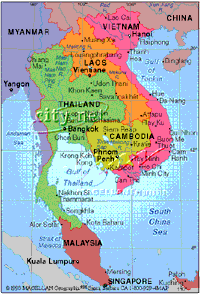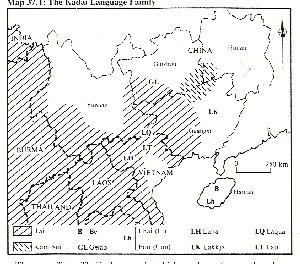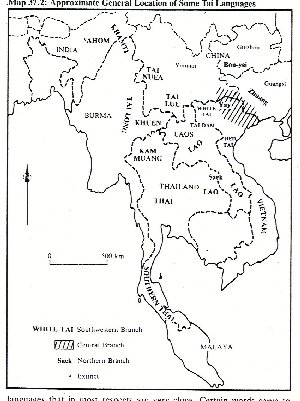Text by Thomas J. Hudak
 Thai (Siamese,Central Thai) belongs to the
Tai language family, a subgroup of the Kadai or Kam-Tai
family. A number of linguists now regard Kam-Tai, along with Austronesian,
as a branch of Austro-Tai, although this hypothesis remains controversial.
Thai (Siamese,Central Thai) belongs to the
Tai language family, a subgroup of the Kadai or Kam-Tai
family. A number of linguists now regard Kam-Tai, along with Austronesian,
as a branch of Austro-Tai, although this hypothesis remains controversial.
All members of the Tai family derive from a single proto-parent designated as Proto-Tai. Linguistic research has shown the area near the border of northern Vietnam and southeastern China as the probable place of origin for the Tai languages. Today the Tai family includes language sporken in Assam, northern Burma, all of Thailand including the peninsula, Laos,northern Vietnam and the Chinese provinces of Yunnan, Guizhou(Kweichow) and Guangxi(Kwangsi). Linguists, notably Fang Kuei Li, divide these languages into a Northern, a central, and a Southwesthern branch. Others, in particular William J. Gedney and A. G. Haudricourt, view the Central and southwesthern branch a single group. In the tripartite division, Thai falls into the southwesthern branch.
Sukhothai, established in central Thailand in the early and mid-thirteenth century, represents the first major kingdom of the Thai. Current theories state that the language spoken in Sukhothai resembled Proto-Tai in tonal structure. This early system consisted of three tones on syllables ending in a long vowel, a semi-vowel or a nasal(kham pen’live syllable’ in traditonal Thai grammatical terms). On syllables ending in p,t,k or in a glottal stop after a short vowel a forth tone existed, althrough these syllables showed no tonal differentiation at all( kham taay ‘dead syllable’ in traditional Thai grammatical terms). While the presents of some type of suprasegmental contrasts is considered conclusive at this early stage of the language , the phonetic nature of these contrasts still remains a matter of speculation. This system prevailed at the time of creation of the writing system by King Ramkhamhaeng(1275-1317) in the latter part of the thirteenth century.
In 1350 the center of power shifted from Sukhothai to Ayutthaya. Recent theories, which will not be discussed here for lack of space, claim that the Sukhothai and Ayutthaya dialects underwent different sound changes. These theories, furthermore, claim that Southern Thai evolved from the Sukhothai dialect and Central Thai or Thai from the Ayutthaya dialect (see Brown 1965). The generally accepted theory, however, holds that Thai descended from the Sukhothai dialect with the following sound changed.
The first of the changes, the sound change known as the tonal split, affected all of the languages in the Tai family. Because of the splits, sound systems with three contrasting tones, for example , became systems typically with six tones , two different tones from each of the three earlier tones. In some dialects , however, special characteristics of the dialect created more or fewer tones. Thai, for example, now have five tones. In brief, these shifts resulted when the phonetic nature of the initial consonant of each syllable conditioned an allophonic pitch difference. Subsequent changes in the initial consonant, then, caused these allophonic non- contrastive pitches to become contrastive (see section two for details of the early tones and the tonal split in Thai). Linguists frequently set a date as early as AD1000 for these sound changes. For the Thai spoken in Ayutthaya, however, the splits seem to have occured much later.
 Several
factors suggest a latter date for the splits in Thai.
Several
factors suggest a latter date for the splits in Thai.
First, late thirteenth-century and early fourteenth-century Ayutthaya poetic compositions appear in the three tone language.
Second, Khmer loanwords, which probably entered the language after the Thai conquest of Angkor in 1431, also predate the splits.
In addition, seventeenth-century descriptions of the Thai alphabet demonstrate that the consonant changes involved with the tonal splits had already taken place by that date.
Citing this evidence, Gedney proposes a date sometime between the mid-fifteenth and the mid- seventeenth centuries for the tonal splits in Thai.The Ayutthaya period (1350-1767) also saw large numbers of Sanskrit and Pali words borrowed, althrough this phenomenon was not strictly limited to this period. These Indic loanwords comprise a large portion of the technical vocablaries for science, government, education, religion and literature. Gedney(1947:1) states that these loanwords are as common in spoken Thai as Latin and Greek forms are in spoken English. Sanskrit and, to a much lesser extent, Pali assume the same cultural importance for Thai as Latin does for English. Many of these loanwords exist in both short and a long forms.The shorter form represents the usual Thai pronunciation: rat’state’, theep’god’. The longer alternant usually, but not always, functions as a combining form: ratthabaan ‘government’ ( latter constituent baan ‘protecter,protection’); theepphabut’angel’(latter constituent but ’son’). Most of these compounds seem to have been formed in modern Thai since they do not appear in either Sanskrit or Pali.
During the Ayutthaya period, Thai began to acquire other characteristics that have let the Thai to regard their language as highly complex and stratified, difficult to acquire even for the very educated. In the past, this impression grew because of the Indic loanwords. But far more central to the creation of this image was the proliferation of titles, ranks, pronouns, royal vocabulary and royal kin terminology that reflected the growing stratification and complexity of the society. Although much of the complexity applied only to the court, Thai speakers nevertheless interpreted these changes as changes in their own language.
Many of these new terms had their original in Sanskrit and Pali. Still others came from Khmer. Khmer institutions had always had an influence on the Thai court and this influence increased when the Thai imported Khmer intelligentsia into Thailand after the fall of Angkor. Royal titles provide a goood example of this increasing complexity. Originally, during the Sukhothai peroid, the Khmer title "khun" referred to the king . By the Ayutthaya period, this title applied only to officials and the king had acquired more elaborate ones. Other changes affected the titles for the king’s offspring. Newly created titles included those for children by the royal queen, for the children by a non-royal queen and for the grandchildren. In the ninteenth-century titles for great-grandchildren and great-great-grandchildren were also added.
In Thailand, Thai serves as the official national language. It is language
taught and used in the schools, the ones used by the media and the one
used for government affairs. According to the 1980 census, 47 million
people live in Thailand. And estimated 80 percent of this total or 37,600,000
people speak Thai.  Outside Bangkok and the central plains, other dialects and languages of
the Tai family coexist with the standard : Northern Thai( Kam Muang or
Yuan) in the north, Southern Thai in the South and Lao or Northeastern
Thai in the northeast. Still other Tai languages such as Lue, Phuthai
and Phuan are spoken as small speech islands in various parts of the country.
In addition, Thailand has many minority groups who speak languages that
do not belong to the Tai family.
Outside Bangkok and the central plains, other dialects and languages of
the Tai family coexist with the standard : Northern Thai( Kam Muang or
Yuan) in the north, Southern Thai in the South and Lao or Northeastern
Thai in the northeast. Still other Tai languages such as Lue, Phuthai
and Phuan are spoken as small speech islands in various parts of the country.
In addition, Thailand has many minority groups who speak languages that
do not belong to the Tai family.
Gedney, William (1947) Indic Loanwords in Spoken Thai, Ph.D. dissertation. Yale University.
Brown, J. Marvin (1965) From Ancient Thai to Modern Dialects. Bangkok: Social Science Association Press of Thailand.